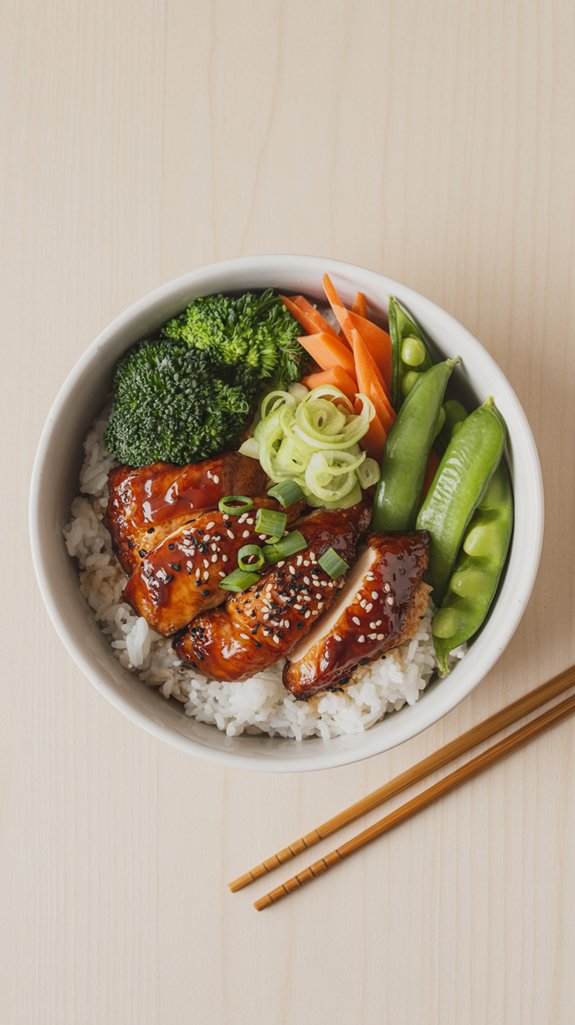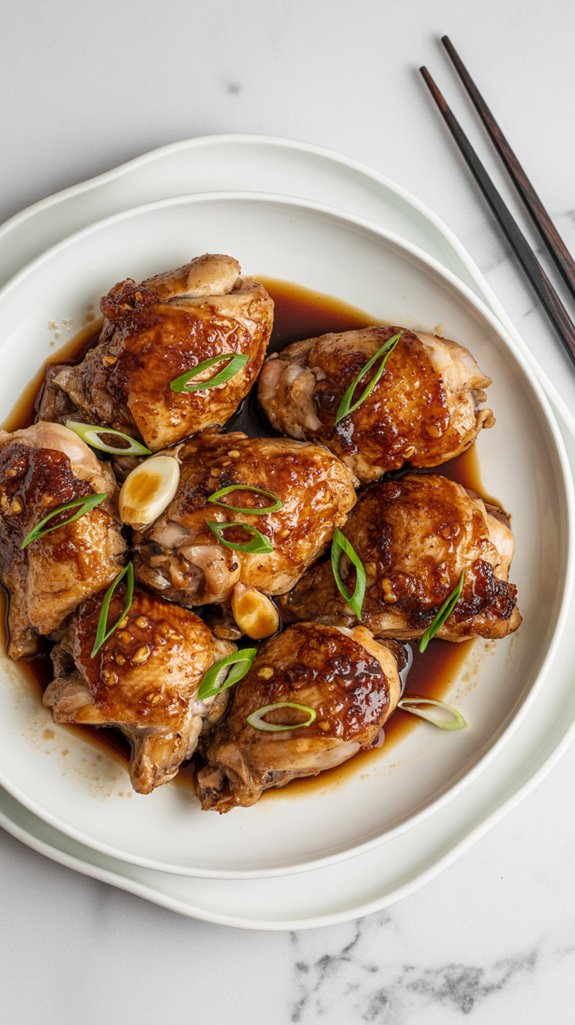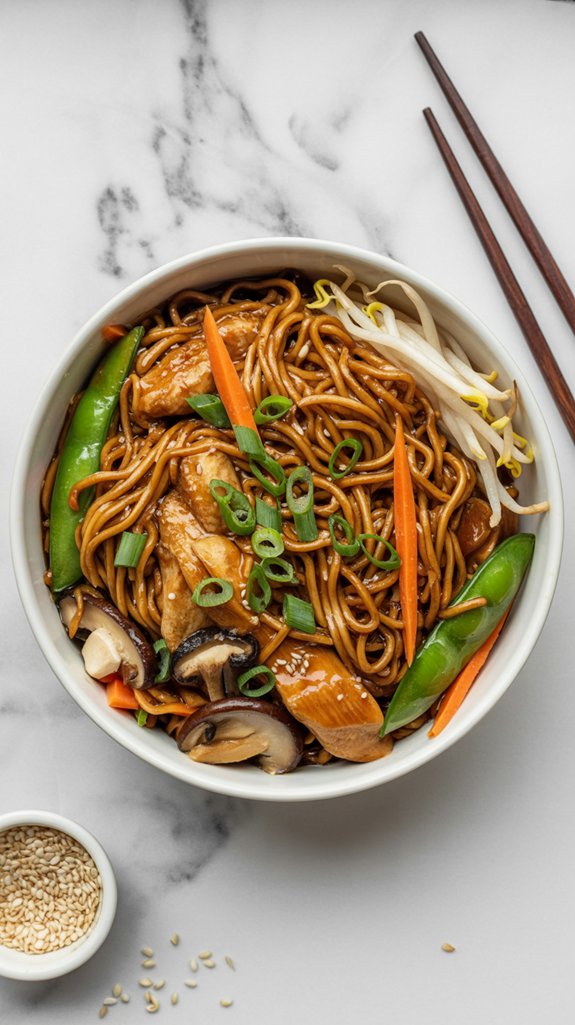Why You’ll Love This this Sweet & Savory Japanese Teriyaki Chicken Bowl
This sweet and savory teriyaki chicken practically cooks itself while you binge-watch your favorite show, because honestly, who’s time to babysit dinner for three hours? The simple ingredient list means you probably already have everything sitting in your pantry right now, which is always a win in my book. Plus, the tender chicken thighs soak up all that glossy, caramelized teriyaki goodness, creating the kind of comfort food that makes you forget you’re technically eating something homemade and healthy.
Ingredients List
Getting this teriyaki chicken on the table requires just five simple ingredients that you probably already have hiding in your kitchen somewhere.
- 2 cups water
- 1 cup soy sauce
- 1/4 cup sugar
- 2 garlic cloves
-
- 8 boneless chicken thighs
- Chicken thighs over breasts: They stay juicy and tender during that long cooking time, plus they’re usually cheaper.
- Low sodium soy sauce option: Feel free to swap regular soy sauce for low sodium if you’re watching your salt intake.
- Fresh vs. bottled garlic: Fresh garlic cloves give better flavor, but honestly, pre-minced garlic from a jar works too when you’re being lazy.
- Sugar substitute: You can use honey or maple syrup instead of white sugar for a slightly more natural sweetness.
- 8 boneless chicken thighs
Step by Step Directions

Making this teriyaki chicken bowl is as simple as combining everything in one pot and letting time do the work.
-
-
- Mix 2 cups water, 1 cup soy sauce, 1/4 cup sugar, 2 minced garlic cloves, and 8 boneless chicken thighs in a large pot.
- Cook on stovetop for 3 hours on low heat, stirring occasionally.
- Alternatively, transfer everything to a slow cooker and cook on low for 3 hours.
- Shred the chicken with two forks once it’s tender enough to fall apart easily.
- Serve over rice with the cooking liquid as sauce.
-
For perfectly cooked rice every time, consider using a professional rice cooker to achieve restaurant-quality results at home.
Substitutions and Variations
• Vegetable additions – Sliced onions, bell peppers, or carrots added in the last hour create a more complete meal.
They soak up all those flavors and give you something besides just chicken and rice.
• Sauce thickening – A cornstarch slurry stirred in during the last 15 minutes makes the cooking liquid more like actual teriyaki sauce instead of seasoned broth.
Additional Things to Serve With This Dish
This dish practically begs for some friends on the plate, and honestly, who am I to deny it what it wants?
-
-
- Steamed jasmine rice – The obvious choice, but let’s be real, it’s obvious because it works. That fluffy, slightly sticky texture catches every drop of sauce like it was born for the job.
- Asian-style coleslaw – Something crunchy and fresh to cut through all that rich, salty goodness. Cabbage with a rice vinegar dressing brings the perfect tangy contrast.
- Pickled cucumbers – Quick pickles take about 10 minutes to throw together, and they add that sharp, clean bite that makes your taste buds wake up between chicken bites.
- Edamame – Toss them with a little sea salt, and you’ve got yourself a protein-packed side that doesn’t compete with the main event.
- Miso soup – Because sometimes you want to lean into the whole Japanese theme, and a warm, umami-rich broth never hurt anybody’s dinner situation.
- Simple green salad – When you realize you haven’t eaten a vegetable all day and your body starts sending you those passive-aggressive signals.
-
Cooking Tips & Tricks (Chef’s Notes)
Look, I’m going to let you in on some secrets that’ll save you from the teriyaki disasters I’ve watched happen in kitchens everywhere.
-
-
- Don’t rush the garlic – Mince those cloves properly, none of this lazy chopping business, because chunky garlic pieces turn bitter and weird when they cook for three hours.
- Skim the surface – About 30 minutes in, you’ll see some foam and scum floating on top, and yeah, it looks gross because it’s gross, so just skim it off with a spoon.
- Check your liquid levels – Three hours is a long time, and if your pot runs dry, you’ll end up with chicken jerky instead of tender, saucy perfection.
- Taste as you go – That sauce should be sweet, salty, and just a little sharp from the garlic, so if it’s too salty, add a splash more water; too bland, maybe another tablespoon of soy sauce.
- Let it rest – When it’s done cooking, resist the urge to plunge right in, because letting it sit for 10 minutes helps the flavors settle and the sauce thicken up naturally.
- Shred with two forks – The chicken should be so tender it falls apart if you look at it wrong, which makes shredding easy work, and shredded chicken holds onto that sauce way better than whole pieces.
- Want to nail those precision vegetable cuts that make this bowl look restaurant-perfect? Our Japanese cooking techniques article breaks down the knife skills that’ll transform your teriyaki game.
-
Nutritional Facts
Based on the complete recipe serving 4 people, here’s what you’re getting per serving:
-
-
- Calories: 285 per serving
- Protein: 35g (excellent source for muscle maintenance)
- Carbohydrates: 8g (mainly from the sugar in the sauce)
- Fat: 12g (primarily from chicken thigh skin and natural fats)
- Sodium: 2,100mg (that’s about 91% of daily recommended intake, so go easy on extra salt)
- Sugar: 6g (from the added sugar in the teriyaki sauce)
- Iron: 15% of daily value (thanks to the dark meat chicken)
- Vitamin B6: 25% of daily value (great for brain function)
- Niacin: 45% of daily value (helps with energy metabolism)
- Phosphorus: 20% of daily value (supports bone health)
-
Fun “Did You Know?”
Beyond those impressive nutrition numbers, teriyaki holds fascinating secrets that’ll make you appreciate this dish even more.
“Teriyaki” literally translates to “glaze-grilled” in Japanese – “teri” means shine or glaze, while “yaki” means grilled or broiled.
I find it amazing that teriyaki sauce wasn’t originally sweet like today’s versions.
Traditional Japanese teriyaki used only soy sauce, mirin, and sake.
The sugary adaptation came when Japanese immigrants brought the technique to Hawaii in the 1960s, creating the sweet-savory balance we love today.
This fusion transformed a simple cooking method into America’s favorite Japanese-inspired dish.





